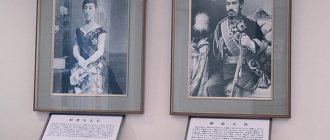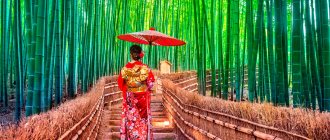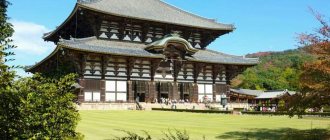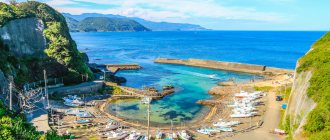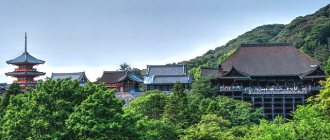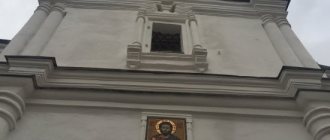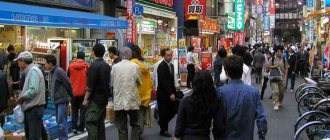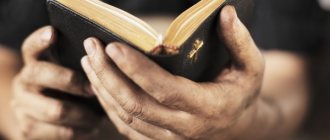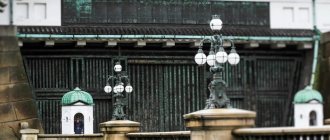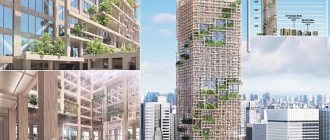Senso-ji Temple (Japan) - description, history, location. Exact address and website. Tourist reviews, photos and videos.
- Last minute tours
around the world
1/
10
Senso-ji Temple
Do you dream of seeing ancient Japan? Welcome to Tokyo's oldest Buddhist temple, Senso-ji. This is one of the few places in the capital where you can mentally travel back several centuries and feel like a discoverer of the mysterious island of samurai and geisha. The temple has several names. The first, more complete one, is Konryuzan Senso-ji. Translated into Russian, it means “temple of young grass on the Golden Dragon Mountain.” The second is Asakusa Kannon. Asakusa is an ancient village and the modern name of the district of Tokyo where the temple stands, and Kannon is the name of the deity in whose honor it was built.
A little history
In the 7th century, at this place two fishermen brothers found a figurine of the incarnation of Buddha - Kannon - the “deity of mercy”. They gave the find to the elder, and he became its guardian and priest. According to legend, a few years later a wandering monk came to the village of Asakusa. The deity appeared to him in a dream and indicated the site of construction of Senso-ji. It burned many times in fires and was rebuilt, expanded its borders, and during the Second World War it was severely destroyed due to bombing. In 1958, it was decided to restore Senso-ji to its 17th-century appearance. The temple is active; up to 30 million pilgrims from Japan and all over the world come here every year.
Asakusa Senso-ji Temple in Tokyo
Asakusa Senso-ji in Tokyo has been the oldest and at the same time outstanding Buddhist temple since the mid-10th century. It is perhaps the most revered Buddhist shrine in Tokyo and one of the most visited places of worship in the country, attracting more than 30 million devotees every year. After reading the article, you will learn more about Asakusa Senso-ji Temple in Tokyo.
1. Briefly about Buddhism in Japan
Buddhism came to Japan from China and Korea during the 6th century. The noble class quickly adopted it as the state religion, but it took some time for it to spread to the common people. Currently, Buddhism and Shintoism in Japan coexist perfectly and complement each other. Many people who follow religious traditions claim to be both Buddhist and Shinto. Next, you will get to know one of the main Buddhist shrines in Tokyo.
2. What is the history of Asakusa Senso-ji Temple in Tokyo?
Senso-ji Temple is one of the main attractions in Tokyo's Asakusa district. Senso-ji Temple Asakusa is the oldest and at the same time outstanding Buddhist temple since the middle of the 10th century.
The history of Senso-ji Temple is as enticing and fascinating as the atmosphere of the place itself.
The golden image of Bodhisattva Kannon (Japanese Goddess of Mercy) was first revealed to the world on March 18, 628, when it got stuck in the fishing net of two brothers, Hamanari and Takenari Hinokuma. This happened while they were fishing in the Sumida Asakusa River. Surprisingly, the statue got caught in the net again and again, although they tried to return it to the river. They eventually gave the shrine to village chief and Buddhist Nakatomo Hajinoatai, who then vowed to become a Buddhist priest. He later made his home a temple to preserve the statue of Kannon Bodhisattva, allowing people near and far to worship the Goddess. Then they decided to hide the statue from human sight in accordance with the revelation from the dream of the famous Buddhist priest Shokai Shonin.
After some time, an ordinary fishing village, Asakusa soon began to prosper. This was due to the countless number of people who visited the village to worship Goddess Kannon. An image identical to the original was created by Ennin, a priest of Enryakuji, during his visit to the temple in the 9th century. Later, the temple underwent improvements thanks to the famous figures of the time who flocked here. The temple subsequently became the center of Edo culture.
Dedicated to Kannon Bodhisattva, the pagoda was originally built in 942 by the warlord Taira no Kinmasa. Unfortunately, since then the temple has been repeatedly destroyed by fires, earthquakes and other disasters, and then rebuilt several times. Also, most of the buildings were destroyed during World War II and later rebuilt. The current building has existed since 1958. It was reconstructed in 1973 after a fire.
Next to Senso-ji Temple is Asakusa Shrine, also called Sanja. This shrine is dedicated to the three founders of Senso-ji Temple. Three Mikoshi are kept here (Hamanari and Takenari Hinokuma, as well as Nakatomo Hajinoatai), each with the spirit (Kami) of one of them.
3. What does Asakusa Senso-ji Temple in Tokyo look like?
Senso-ji Temple is a Buddhist shrine. It is dedicated to Guan Yin or Kannon Bodhisattva, the many-armed Goddess of mercy and happiness who is believed to have protected the Japanese people for more than 1,500 years. This is one of her images.
When you reach Senso-ji Temple, you will be greeted by the Kaminari (thunder gate) that dominates the temple entrance. This striking gate features a huge paper lantern enhanced by vibrant reds and blacks, which in turn represent lighting and storm clouds. Here, a 200-year-old market selling traditional and non-traditional souvenirs stretches along the street between the thunderous Kaminari Gate.
From Kaminari (about 200 meters) there are numerous stalls with amazing souvenirs that will lead you to the second gate of the temple, called Hozomonu (treasury gate). When you pass through this gate, you will find the main building along with an astounding 5-story pagoda.
The temple's must-see attractions include the national treasure main hall, built by Tokugawa Iemitsu, the third shogun of Edo. It is home to Yakushido Hall, an elegant structure built in the 17th century. Nitenmon Gate has been declared an important cultural property by the Japanese government. Bentendo Hall houses the deity Benzaiten. Awashimado Hall is dedicated to the deity of Wakayama Prefecture.
If you are in Tokyo, be sure to visit this amazing temple. Senso-ji Temple in Asakusa will not disappoint you with its serene and meditative atmosphere. It is one of the most visited places of worship in the country, attracting over 30 million devotees every year.
Senso-ji Temple is also home to many events, including the Sanja Matsuri (dedicated to the founders of Senso-ji Temple), Hozuki-Ichi, Asakusa Samba Carnival and Tokyo Jidai Matsuri.
This is the information about Asakusa Senso-ji Temple in Tokyo!
What to see
Right at the first gate, tourists are greeted by a huge paper lantern with hieroglyphs. It means "heavenly fire piercing the clouds." This massive gate is called Kaminari-mon - “Gate of Thunder”. The entrance is guarded by two guards - the deities of Thunder and Wind.
The lantern did not always hang here. It was presented to the temple by the president of Matsushita Electronics after he was cured of pain in his leg that even doctors could not cope with.
Immediately outside the gate begins the Nakamise-dori shopping street - in the old days, things related to religion and food were sold here. Now you can buy Japanese souvenirs and local sweets here. Senso-ji is one of the few Buddhist temples that allowed trade on its territory in the 18th century. The street ends with another gate - Hozo-mon, which has two floors. The second floor is occupied by a treasury where Chinese religious books from the 13th to 15th centuries are kept. The gate was built in the 10th century at the behest of a military leader who dreamed of becoming the local leader, and his wish came true. They are also protected by two Nio guards. The temple complex contains 5 pagodas and a main hall where a statuette of the deity of mercy Kannon is still kept.
Before starting prayer, you need to wash your hands, rinse your mouth with water and undergo fumigation at the huge censer standing in the center of the hall. After this, clap your hands twice to attract the deity’s attention and throw a coin. Now you can turn to heaven. Pilgrims believe that if they take a piece of incense from Senso-ji and rub it on the sore spot, the disease will go away. Here you can choose your “destiny”. For a small fee they will give you a fortune telling in Japanese. If you don't like it, just leave it in the temple.
Wait until it gets dark. The lights will turn on, and the temple will appear in a completely different form.
Kaminarimon (Kaminari Gate - Thunder Gate)
Kaminarimon is the first of two large entrance gates leading to Senso-ji Temple. First built over 1000 years ago, they are the symbol of Asakusa.
The giant lantern on the gate is 3.9 meters high, 3.3 meters wide and weighs 700 kilograms. This chochin type lantern has a spiral bamboo frame covered with hundreds of sheets of paper. This spiral frame allows the lantern to be rolled up during the Sanya Matsuri festival, when portable shrines must pass through the gate.
The main attraction of Asakusa is the Buddhist temple Sensoji , built in the 7th century. Nakamise leads to the temple . Along with typical Japanese souvenirs such as yukatas and folding fans, various traditional local snacks from the Asakusa area are sold along Nakamise. The shopping street has a history of several centuries.
Nakamise Shopping Street leads from the outer gate to the temple's second gate, Hozomon . Outside the Hozomon Gate is the temple's main hall and five-story pagoda. Buildings destroyed during the war were reconstructed.
Lunch in Asakusa
Asakusa is a very pleasant and beautiful place to walk. Here you can buy souvenirs, have lunch in a restaurant, take a walk in the park, or visit an ancient Buddhist temple. As for souvenirs, I bought figurines of lucky cats - maneki-neko, a yukata for my son, a wallet and a handbag.
We had lunch at the Aduma . Lunch for two with sake cost 4,930 yen.
Address: Asakusa Umaimon Aduma, 1 Chome-32-1 Asakusa, Taito City, Tokyo
The photo below shows real food and dummies on display.
